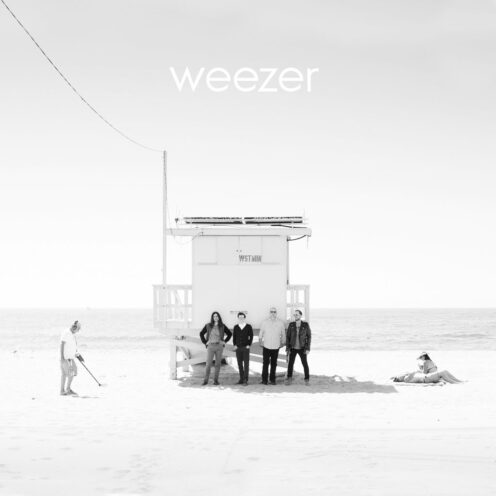
This is not Pinkerton.
Now that we have that out of the way, let’s examine where this 10th LP (fourth self-titled) fits within The Curious Case of Weezer.
To many, Weezer are hacks; they’re notorious for “selling out” (whatever that means), a band who’s switched not only styles but a frontman who famously experimented with hundreds of songwriting methods just to reach the heights of the band’s classic debut, Weezer (The Blue Album). But it’s what’s happened between the time of The Blue Album and now that makes the band (and their enigmatic frontman, Rivers Cuomo) so endearing. There was critical success followed by critical failure; addiction followed by isolation, all in the name of goofy songs like “Hash Pipe” and “Island in the Sun.” There was celibacy, meditation, marriage, divorce, a Lil Wayne feature, and a “return to form” all in the past two decades.
But this could be any band’s history. When you’re around for 20 years, you’re bound to experience changes in your personal life that affect the songs you write, hopefully in a positive way. All of this information might be irrelevant if we were talking about another band, but it’s Weezer’s ties to the scene that keep even their harshest critics coming back album after album. Most of it has to do with Pinkerton’s status as a pillar of modern emo, but reflections of the band’s entire discography can be seen in wake of other scene favorites, from indie all-stars like Brand New and Manchester Orchestra to looser, pop-driven acts like Fall Out Boy and Motion City Soundtrack (R.I.P.).
So where does this leave the Weezer of 2016? Coming off the heels of Everything Will Be Alright in the End, a surprising return to form, what are fans to make of The White Album? Simply put, The White Album is a fun one, a light-hearted companion piece void of the darker lyrical themes of its predecessor. In fact, if EWBAITE was almost total fan service, The White Album strikes a near-perfect balance between what fans want from Weezer and what they’ve come to expect from Weezer in 2016.
Inspired by friends and strangers found on the beaches of California, The White Album tips its hat to The Beach Boys nearly as often as it does the band’s back catalog. This is never more apparent that on “(Girl We Got A) Good Thing,” one of the poppiest songs Rivers and co. have ever written. Oddly enough, much of The White Album calls back to the low points of Weezer’s discography — Make Believe, The Red Album, etc. — presented now with 100% more purpose and conviction; polished guitars, bouncing pianos and sleigh bells lead the song’s standout chorus into verses filled with chugging guitars and a solo-centric bridge.
The songs here are sonically split between singles like the album’s crunchy opening track, “California Kids,” (complete with a grin-inducing allusion to Pet Sounds in its opening glockenspiel notes) and the polarizing weirdness of “Thank God for Girls.” Perhaps unsurprisingly, it’s songs like the former that stand out upon repeated listens, though the band’s experimentation with piano-driven pop does have its place. And when the two blend, the music is truly irresistible; it would be silly for a song like “Wind in Our Sail” not to be the next official single, because in essence, it combines everything current fans love about with just enough of the aforementioned elements (and unexpected vocal play from Cuomo) to best represent the album’s stylistic ambitions.
So where does The White Album fall short? Despite its flashy, rejuvenated energy, these songs simply lack the substance present throughout EWBAITE. I know what you may be thinking; Weezer has never been a lyric-driven band, and they’ve certainly never been a band expected to write about death and divorce all of the time. Put simply, the fun-loving fantasy lyrics featured here don’t reach the emotional heights of a line like, “That’s human nature/We fail each other/And keep on searching for another” (from “Ain’t Got Nobody). Still, Cuomo manages to dig up a tense anecdote about addiction (the Green Album-referencing “Do You Wanna Get High?”) and, much like a similar album released by The Front Bottoms last year, some engaging observations on masculinity and gender roles (“Thank God For Girls”). In fact, Cuomo even took the time to annotate these songs himself. “Summer Elaine and Drunk Dori” remains memorable for it’s grungy guitar riff and sudden key changes, but the album’s penultimate number (“Jacked Up”) is regrettably anti-climatic, bringing an unremarkable close to an otherwise charming listen.
Somebody asked me a few weeks ago whether or not I thought “Weezer was back,” and truly, I’m not even sure I know what that means. So much of songwriting is subjective; I tend to think Make Believe is a better album than most because it was my first Weezer album. And you know what? I think The Red Album is really, really bad for the most part. But what I can say for certain about The White Album (and its predecessor) is that for the first time since 2002, it sounds like Weezer are not only enjoying the music they’re making, but living up to the admittedly impossible standards some Blue Album and Pinkerton purists tend to hold. With The White Album, Weezer solidify their place as a more-than-capable modern pop-rock band, and if that means as much to you as it does to me, we’re left with hope that Rivers and co. will continue to grace us with as many sonic experiments as they have left in their KISS-worshipping bodies.